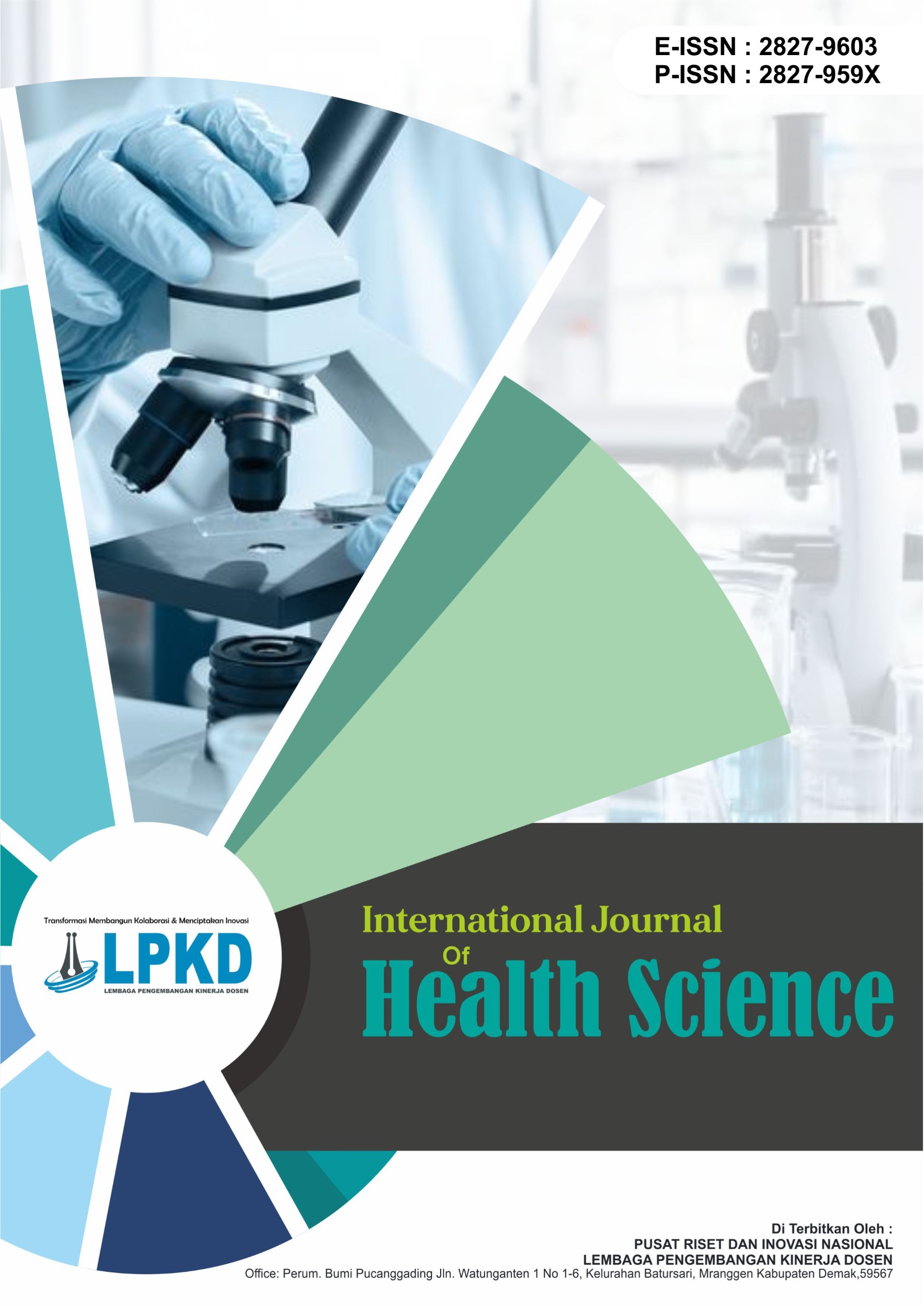Effectiveness of Hypnobreastfeeding on Exclusive Breastfeeding at Mumbulsari Community Health Center Work Area
DOI:
https://doi.org/10.55606/ijhs.v5i3.6025Keywords:
Breastmilk, Exclusive breastfeeding, Hypnobreastfeeding, Post-natal, PregnantAbstract
Exclusive breastfeeding is the best period of breast feeding intake for infants because it maximizes health benefits for growth and development. However in reality, there are many hindrances for mothers to give exclusive breastfeeding. Negative perceptions from the mothers itself regarding breast milk often caused the low rates of exclusive breastfeeding. Conventional therapies that has been given only solved one problem at a time, while the actual solution is a holistic care which includes mind, body, and soul. Hypnobreastfeeding is one of the preferred therapy that contains holistic care to improve the exclusive breastfeeding. The aim of this study is to analyze the effect of hypnobreastfeeding on exclusive breastfeeding at Mumbulsari Community Health Center, Jember, East Java, Indonesia. This study used pre-experimental design with post-test only design on pregnant women in third trimester. Simple random sampling was used as sampling technique with 16 treatment group and 16 control group which fulfill inclusion and exclusion criteria. The experimental data was collected using observation sheets which then statistically analyzed using bivariate chi-square test. The result of chi-square test showed that p=0,003 (p < 0,05) which shows that hypnobreastfeeding positively influence exclusive breastfeeding. In conclusion, hypnobreastfeeding is strongly suggested as the treatment to improve exclusive breastfeeding on mothers.
Downloads
References
Ayele, W. M., Tegegne, T. B., & Mekonen, A. M. (2025). A community-based father education intervention on breastfeeding practice in Ethiopia: A quasi-experimental study. BMC Pediatrics, 25(1). https://doi.org/10.1186/s12887-024-05372-z
Buccini, G. dos S., Pérez-Escamilla, R., Paulino, L. M., Araújo, C. L., & Venancio, S. I. (2016). Pacifier use and interruption of exclusive breastfeeding: Systematic review and meta-analysis. Maternal and Child Nutrition, 13(3). Blackwell Publishing Ltd. https://doi.org/10.1111/mcn.12384
Dinas Kesehatan Jember. (2021). Profil Kesehatan Tahun 2021. Dinas Kesehatan Kabupaten Jember. https://www.dinkesjember.go.id
Eland, J. (2013). The hypnotic oxytocin complex. https://hypnosementor.nl/en/hypnotic-oxytocin-complex/
Evawanna, A.D., & Sembiring, E. (2024). Hypnopressure terhadap breastfeeding self-efficacy dan produksi ASI pada ibu menyusui. Optimal Midwife Journal, 1(1), 1-12. https://doi.org/10.34008/jurhesti.v6i2.245
Gaparini, A., Astutik, L. P., & Meyasa, L. (2024). Hypnobreastfeeding meningkatkan pengeluaran ASI pada ibu nifas. Jurnal Kebidanan Malakbi, 5(2), 114. https://doi.org/10.33490/b.v5i2.975
Gayatri, M. (2021). Exclusive breastfeeding practice in Indonesia: A population-based study. Korean Journal of Family Medicine, 42(5), 395-402. https://doi.org/10.4082/kjfm.20.0131
Gunawan, A. W. (2010). Hypnotherapy: The art of subconscious restructuring. PT Gramedia Pustaka Utama.
Minrong, I. D., & Yulianti, H. (2023). Asuhan kebidanan nifas & menyusui (1st ed.). Renca Cipta Mandiri.
Muhepi, D., & Murtiningsih, A. (2012). Melahirkan tanpa rasa sakit dengan metode hypnobirthing. Dunia Sehat.
Nagel, E. M., Howland, M. A., Pando, C., Stang, J., Mason, S. M., Fields, D. A., & Demerath, E. W. (2023). Maternal psychological distress and lactation and breastfeeding outcomes: A narrative review. Clinical Therapeutics, 44(2), 215-227. https://doi.org/10.1016/j.clinthera.2021.11.007
Nathalia, A., Rahmawati, D., Nastiti, K., & Salmarini, D. D. (2024). Factors influencing the occurrence of exclusive breastfeeding failure in six-month-old infants. Health Sciences International Journal, 2(2), 96-103. https://doi.org/10.71357/hsij.v2i2.31
Reni, D. P., Puspitaningsih, R., Wati, R., & Nurachma, E. (2023). The Effectiveness Combination of Hypnobreastfeeding and Breast Exercises on Breast Milk Production Time in Third Trimester Pregnant Women. PLACENTUM Jurnal Ilmiah Kesehatan Dan Aplikasinya, 11(1), 2023. https://doi.org/10.20961/placentum.v11i1.66967
Rohmah, M., Wahyuni, C., & Mufida, R. T. (2021). The effect of hypnosis breastfeeding (hypnobreastfeeding) on breastfeeding self-efficacy in postpartum mothers at Kediri City. STRADA Jurnal Ilmiah Kesehatan, 10(2), 1518-1523. https://doi.org/10.30994/sjik.v10i2.857
Sembiring, G., Damayani, A. D., Aziz, M. A., & Gurnida, D. A. (2024). Efektivitas model edukasi dan dukungan menyusui untuk meningkatkan breastfeeding self-efficacy dan pemberian ASI eksklusif: Scoping review. Media Penelitian dan Pengembangan Kesehatan, 34(2), 440-453. https://doi.org/10.34011/jmp2k.v34i2.2024
Setiawan, A., & Saryono. (2011). Metodologi kebidanan DIII, DIV, S1 dan S2. Nuha Medika.
Sudfeld, C. R., Fawzi, W. W., & Lahariya, C. (2012). Peer support and exclusive breastfeeding duration in low and middle-income countries: A systematic review and meta-analysis. PLoS ONE, 7(9), e45143. https://doi.org/10.1371/journal.pone.0045143
Virgian, K. (2022). Menstrual cycle determinants. International Journal Scientific and Professional (IJ-ChiProf), 1(2), 40-47. https://doi.org/10.56988/chiprof.v1i2.6
Wardani, E. K., Magfiroh, R. U. L., & Purnamasari, D. (2024). Pengetahuan tentang manajemen laktasi pada ibu menyusui mendukung keberhasilan ASI eksklusif. Oksitosin: Jurnal Ilmiah Kebidanan, 11(1), 23-36. https://doi.org/10.35316/oksitosin.v11i1.4191
Widayanti, W., Sari, V. M., Aliah, N., & Tonasih, T. (2022). HIPNOSI (lactation hypnosis) for improving breast milk production. PLACENTUM: Jurnal Ilmiah Kesehatan dan Aplikasinya, 10(3), 214. https://doi.org/10.20961/placentum.v10i3.66570
World Health Organization. (2025). Global breastfeeding scorecard 2024: Meeting the global target for breastfeeding requires bold commitments and accelerated action by governments and donors (CC BY-NC-SA 3.0 IGO licence). https://www.globalbreastfeedingcollective.org/media/2856/file
Yulianto, A., Safitri, N. S., Septiasari, Y., & Sari, S. A. (2022). Frekuensi Menyusui Dengan Kelancaran Produksi Air Susu Ibu. Jurnal Wacana Kesehatan, 7(2), 68. https://doi.org/10.52822/jwk.v7i2.416
Downloads
Published
How to Cite
Issue
Section
License
Copyright (c) 2025 International Journal Of Health Science

This work is licensed under a Creative Commons Attribution-ShareAlike 4.0 International License.







